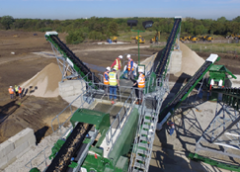They also visited the CDE Demonstration Event held at GS Materials in Candor, N.C., a few months later. CDE has a 300-tph turnkey wash plant installed at the site, and the demonstration event allowed attendees to see the equipment in operation, watching the entire process and viewing the final products.
“We were immediately impressed by the plant’s ability to manage gradation and silt cuts – producing golf course spec sand the first pass. With conventional classifying equipment and sand screws this is difficult to say the least,” said Keith Newell, president of Metroplex Sand & Gravel. He chose the M4500 to be installed at the company’s Fort Worth, Texas, plant, along with a selection of other equipment from the CDE portfolio to meet the finished product requirements.
The M4500
The M4500 consists of a modular wash plant with a maximum feed capacity of 450 tph via direct feed and integrates a feed system, aggregate screening, sand washing and stockpiling on a single chassis allowing for rapid deployment on site, while also minimizing the space required to accommodate the plant. And when required, the plant also accepts crushed material directly to the feed boot from a transfer conveyor.
In 2015, CDE concluded the project and installed five machines at the pit operated by Metroplex Sand & Gravel: the M4500 modular wash plant, the AggMax portable logwasher, the Counter Flow Classification Unit (CFCU), the EvoWash fines recovery unit and the AquaCycle thickener.
The +3-in. material is delivered to an oversize stockpile from the top deck of the rinsing screen on the M4500 with the material between ¼ to 3 in. is transferred to the AggMax. Once the gravel has been scrubbed to remove clays, it is being stockpiled into two products grades: ¼ to 2-in. and ½ to 1½ in. The AggMax also includes a dewatering screen at the rear which accepts the lightweight organics floated off from the gravel fraction and dewaters these before stockpiling in a product bay underneath the machine.
The minus ¼-in. material is then sent to the sand washing element of the M4500 which is configured with a dual pass cyclone arrangement. The sand material is first delivered to two 25-in. cyclones where the first separation occurs. The material is then discharged from the cyclones to one side of an A-Series VibroSync split dewatering screen before the coarse sand is stockpiled via a radial stockpile conveyor.
Some material is allowed to pass through the dewatering screen to the sand plant sump and this material is then sent to the Counter Flow Classification Unit (CFCU) which facilitates further density separation by using an upward flow of water to carry lighter particles up while allowing the heavier particles to fall to the bottom of the CFCU tank.
The material from the bottom of the tank is then delivered to the second side of the split A-series VibroSync dewatering screen and a 100 mesh to 18 mesh fine sand product is stockpiled via the integrated M4500 stockpile conveyor. Meanwhile the lightweight material from the CFCU is delivered to an additional EvoWash 71 sand washing plant where a 200 mesh to 50 mesh cushion sand product is stockpiled.
The plants also include an AquaCycle A600 thickener, which accepts all the waste water, and minus 200 mesh fines, which are dosed with flocculants on entry to the tank. This facilitates the settlement of the fine particles to the bottom of the thickener tank while the clean water overflows the peripheral weir and is recycled to the wash plant.
“The modularity and relatively small foot print of the M4500 is an obvious plus and the time it has all taken to come together has been shorter than we would have thought possible” Newell said. “The quality of equipment design and the strength of its manufacturing are truly remarkable as well, as is the precision with which the plant fits together. Perhaps most important, the AquaCycle thickener greatly diminishes our freshwater requirements. Our current plant requires 6,000 gpm; the M4500 – although it uses approximately 2,600 gpm – requires only 300 gpm of new water.”
Information for this article courtesy of CDE.

